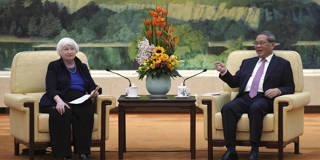A global economic slowdown, together with rising geopolitical tensions, has led to overcapacity in crucial Chinese industries like alternative energy and electric vehicles. The only feasible solution is for Chinese companies to expand their overseas investments, particularly in the United States.
BEIJING – During her recent visit to Beijing, US Treasury Secretary Janet Yellen criticized her Chinese counterparts, arguing that China’s government subsidies have led to overcapacity in crucial sectors like alternative energy and electric vehicles (EVs). This, she contended, provides Chinese companies with unfair cost advantages that enable them to outcompete American firms. But while Yellen was right to point out China’s overcapacity problem, her assertion that government subsidies are the root cause was misplaced.
For Chinese people of my generation, the leap from scarcity to abundance over the past four decades has been a dream come true. Until the early 1990s, everything in China was rationed; nowadays, it is hard to find anything that is not readily available.
China’s experience is not unique. Japan underwent a similar transformation after World War II, as decades of export-led growth enabled the country to rebuild and develop its industry. But the collapse of the Bretton Woods system in 1971, followed by that decade’s oil shocks, forced Japanese companies to focus on domestic, consumer-led growth. This shift quickly resulted in overcapacity and triggered numerous trade disputes between the United States and Japan throughout the 1980s.

BEIJING – During her recent visit to Beijing, US Treasury Secretary Janet Yellen criticized her Chinese counterparts, arguing that China’s government subsidies have led to overcapacity in crucial sectors like alternative energy and electric vehicles (EVs). This, she contended, provides Chinese companies with unfair cost advantages that enable them to outcompete American firms. But while Yellen was right to point out China’s overcapacity problem, her assertion that government subsidies are the root cause was misplaced.
For Chinese people of my generation, the leap from scarcity to abundance over the past four decades has been a dream come true. Until the early 1990s, everything in China was rationed; nowadays, it is hard to find anything that is not readily available.
China’s experience is not unique. Japan underwent a similar transformation after World War II, as decades of export-led growth enabled the country to rebuild and develop its industry. But the collapse of the Bretton Woods system in 1971, followed by that decade’s oil shocks, forced Japanese companies to focus on domestic, consumer-led growth. This shift quickly resulted in overcapacity and triggered numerous trade disputes between the United States and Japan throughout the 1980s.